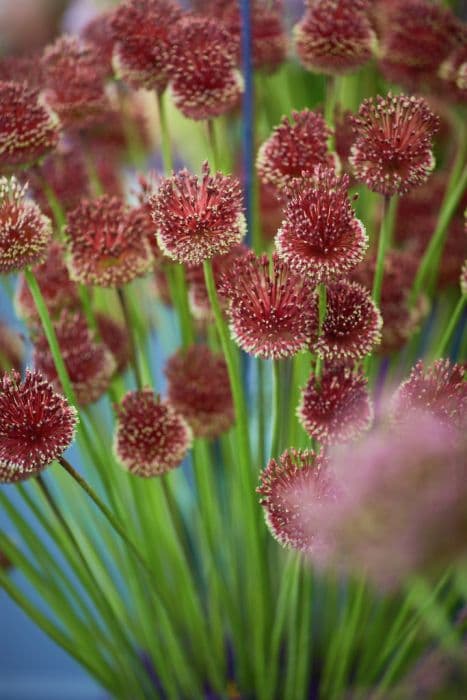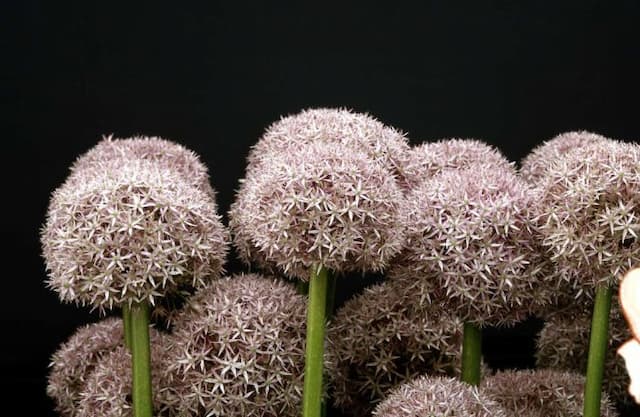Giant Allium Allium 'Globemaster'

ABOUT
The Globemaster is a stunning ornamental onion with showy and vibrant spherical flower heads that are known for their impressive size. The flowers are composed of hundreds of tiny florets that are packed closely together to form a rounded, globe-like shape. The florets are a rich, deep purple in color, and they exude a distinctive onion-like fragrance when crushed or bruised. This bold and eye-catching flower cluster sits atop a tall, sturdy stem, which rises from a clump of strappy, green, glossy leaves. The leaves are linear and somewhat fleshy with a slight arch, providing an elegant contrast to the rigid stems. The Globemaster's striking appearance makes it a favorite among gardeners looking to add a dramatic splash of color and structural interest to their landscapes.
About this plant
 Names
NamesFamily
Amaryllidaceae.
Synonyms
Ornamental Onion, Giant Allium, Allium 'Globemaster'.
Common names
Allium 'Globemaster'
 Toxicity
ToxicityTo humans
Allium 'Globemaster', commonly known as 'Ornamental Onion', is generally not considered toxic to humans. However, ingestion in very large quantities may cause gastrointestinal discomfort, including symptoms like nausea, vomiting, and diarrhea due to its strong, pungent nature. Such symptoms are typically not severe but can be uncomfortable. It is important to note that all parts of the plant have the potential to cause these symptoms if consumed in excess.
To pets
'Ornamental Onion' is toxic to cats and dogs. If pets ingest this plant, they can suffer from symptoms of Allium toxicosis. Symptoms may include vomiting, diarrhea, abdominal pain, lethargy, elevated heart and respiratory rates, weakness, and even collapse. Another serious potential consequence is the development of hemolytic anemia, as compounds in the plant can cause the breakdown of red blood cells. If you suspect your pet has ingested 'Ornamental Onion', it is crucial to seek veterinary attention promptly.
 Characteristics
CharacteristicsLife cycle
Perennials
Foliage type
Deciduous
Color of leaves
Green
Flower color
Purple
Height
3-4 feet (0.9-1.2 meters)
Spread
1-2 feet (0.3-0.6 meters)
Plant type
Bulb
Hardiness zones
5
Native area
Eurasia
Benefits
 General Benefits
General Benefits- Attractive Blooms: Allium 'Globemaster', commonly known as ornamental onion, produces large, spherical clusters of purple flowers that add aesthetic appeal to garden landscapes.
- Low Maintenance: It requires minimal care once established, which makes it an easy plant for gardeners of all skill levels.
- Drought Tolerant: Ornamental onion is quite drought-resistant, reducing the need for frequent watering.
- Pest Resistant: This plant is naturally resistant to pests, including deer and rodents, protecting other plants in its vicinity.
- Pollinator Friendly: The blooms of the Allium 'Globemaster' attract bees, butterflies, and other pollinators, supporting biodiversity in the garden.
- Long-Lasting Flowers: The flowers have a lengthy bloom time and can also be used for dried flower arrangements, providing long-term value.
- Architectural Interest: With its tall stems and eye-catching flower heads, this plant adds vertical interest and structure to garden beds and borders.
- Easy to Combine: It pairs well with a wide variety of other plants and flowers, offering flexibility in garden design.
- Multiplication Over Time: Ornamental onions can multiply over the seasons, providing more plants for expansion or sharing with other gardeners.
 Medical Properties
Medical PropertiesThis plant is not used for medical purposes.
 Air-purifying Qualities
Air-purifying QualitiesThis plant is not specifically known for air purifying qualities.
 Other Uses
Other Uses- Allium 'Globemaster' can be used as a natural pest repellent in gardens because its strong scent can deter rodents and deer from feasting on nearby plants.
- The tall and sturdy stems of Globemaster can be used as natural plant supports for lighter, floppy plants or vines in a mixed flower bed.
- Dried Globemaster flower heads can be used to create decorative wreaths and floral arrangements that last for months.
- The vibrant purple blooms can also serve as a natural dye source for fabrics, yielding hues of light purple or lilac.
- Dried Allium 'Globemaster' heads can be used in crafts, such as making botanical suncatchers or embedding them in homemade candles for decoration.
- Globemaster flowers can be used as a natural confetti for outdoor celebrations, as they are biodegradable and environmentally friendly.
- The bulbs of Globemaster can be crushed and used in compost piles to accelerate decomposition and add essential nutrients.
- Allium 'Globemaster' can act as a companion plant, enhancing the growth and flavor of certain vegetables and herbs when planted nearby.
- Farmers and beekeepers may use Globemaster in or near their fields and hives to attract pollinators such as bees and butterflies to crops and gardens.
- The aesthetic appeal value of Globemaster can be harnessed to improve the visual impact of otherwise stark architectural landscapes.
Interesting Facts
 Feng Shui
Feng ShuiThe ornamental onion is not used in Feng Shui practice.
 Zodiac Sign Compitability
Zodiac Sign CompitabilityThe ornamental onion is not used in astrology practice.
 Plant Symbolism
Plant Symbolism- Unity: The spherical shape of the 'Globemaster' flowerhead is often seen as a symbol of unity and togetherness, representing how many separate flowers come together to form one whole.
- Patience: As a plant that takes several years to bloom to its full potential, it symbolizes the virtue of patience and the reward of waiting.
- Strength: The sturdy stalks of the Allium 'Globemaster' can represent strength and resilience, as they stand tall and support the large flower heads.
- Prosperity: Due to its large and impressive bloom, it can symbolize abundance and prosperity.
- Protection: Historically, all alliums have been thought to have protective qualities, therefore, planting them in gardens was believed to ward off negative energies and pests.
- Eternal Life: The Allium 'Globemaster', with its perennial nature and recurring blooms, is sometimes associated with the concept of eternal life and continuity.
 Water
WaterThe Ornamental Onion 'Globemaster' should be watered thoroughly once a week during its active growth period. In the absence of rain, provide about 1 inch of water to the plant to ensure the soil is moist but not waterlogged. During the dormant season, after the leaves have died back, reduce watering significantly. It's important to avoid overwatering as this can lead to bulb rot. Adjustments may be needed depending on the weather conditions; more water may be needed in hot, dry periods and less during cool, wet spells.
 Light
LightThe Ornamental Onion 'Globemaster' thrives in full sun conditions. It is best positioned in a spot where it will receive at least 6 to 8 hours of direct sunlight each day. This plant prefers a bright and unshadowed location to develop its large, striking flower heads effectively.
 Temperature
TemperatureThe Ornamental Onion 'Globemaster' can survive winter temperatures as low as 0 degrees Fahrenheit and is hardy in USDA zones 5 through 8. The ideal growing temperature for this plant is between 60 and 70 degrees Fahrenheit during the spring and fall growth periods. Although this plant can tolerate summer heat, it goes dormant in the summer after flowering when temperatures are high.
 Pruning
PruningThe Ornamental Onion 'Globemaster' requires minimal pruning. Deadhead the spent flower heads after blooming to encourage the plant to put its energy into bulb growth. However, you should leave the foliage in place until it dies back naturally, as it will continue to photosynthesize and strengthen the bulb for the next season. Pruning typically occurs in late summer or early fall as the leaves yellow and wither.
 Cleaning
CleaningAs needed
 Soil
SoilThe Ornamental Onion 'Globemaster' thrives in a well-draining soil mix with a pH of 6.0 to 7.5. For the best results, mix loamy garden soil with compost and a handful of coarse sand to improve drainage. Annual enrichment with organic matter can help provide the necessary nutrients.
 Repotting
RepottingOrnamental Onion 'Globemaster' bulbs should be lifted and divided every 3 to 4 years to maintain vigor. They do not require frequent repotting; instead, they prefer to be undisturbed to naturalize and multiply.
 Humidity & Misting
Humidity & MistingOrnamental Onions prefer outdoor conditions and are not demanding in terms of humidity. They thrive in average garden humidity levels and do not require any special humidity adjustments.
 Suitable locations
Suitable locationsIndoor
Place in a bright spot, keep soil lightly moist.
Outdoor
Plant in full sun, well-drained soil, space bulbs 8-12 inches.
Hardiness zone
4-9 USDA
 Life cycle
Life cycleThe 'Globemaster' ornamental onion begins its life as a dormant bulb, planted in the fall before the first frost. In spring, the bulb germinates, sending up long, strappy leaves and a sturdy stalk as it enters the vegetative growth stage. By late spring to early summer, the plant develops a large, spherical cluster of star-shaped flowers, typically violet-purple in color, which attracts pollinators to the garden. After flowering, the plant enters the senescence phase; the leaves yellow and wither as the plant directs energy back into the bulb for next year's growth. The seed heads dry out and can either be collected for propagation or left to self-seed in the garden. Come late summer or fall, the foliage completely dies back, and the plant re-enters dormancy until the next growing season.
 Propogation
PropogationPropogation time
Early autumn
The best time to propagate the ornamental onion 'Globemaster' is in the late summer to early fall, after the foliage has died back and the plant is dormant. The most popular method of propagation for this plant is by dividing the bulb clusters. To do this, carefully lift the bulbs from the ground using a garden fork, taking care not to damage the bulbs. Gently separate the cluster into individual bulbs, making sure that each section has a portion of the base plate. Replant the bulbs immediately at a depth of about 6 to 8 inches (15 to 20 centimeters) and spaced approximately 8 to 12 inches (20 to 30 centimeters) apart, allowing adequate room for the plants to grow. This will allow the bulbs to establish roots before the onset of winter and be ready to grow in the spring.









